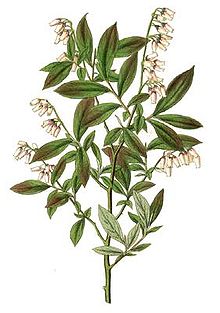Vaccinium virgatum: Difference between revisions
| Line 45: | Line 45: | ||
{{Ericaceae-stub}} |
{{Ericaceae-stub}} |
||
{{fruit-stub}} |
{{fruit-stub}} |
||
References |
==References== |
||
<references /> |
<references /> |
||
Revision as of 12:29, 1 July 2011
| Rabbiteye Blueberry | |
|---|---|

| |
| Scientific classification | |
| Kingdom: | |
| (unranked): | |
| (unranked): | |
| (unranked): | |
| Order: | |
| Family: | |
| Genus: | |
| Species: | V. virgatum
|
| Binomial name | |
| Vaccinium virgatum | |
Rabbiteye Blueberry (Vaccinium virgatum, also known as V. ashei) is a species of blueberry native to the Southeastern United States, from North Carolina south to Florida and west to Texas. Other common names include Southern Highbush Blueberry, Southern Black Blueberry, and Smallflower
Description
Vaccinium virgatum' is a deciduous shrub growing to 4 m tall, though usually less, commonly only 1-2 m tall. The leaves are spirally arranged, oblanceolate to narrow elliptic, 3-6 cm long. The flowers are white, bell-shaped, 5 mm long. The fruit is a berry 5 mm diameter, dark blue to black, bloomed pale blue-gray by a thin wax coating.
Characteristics
Rabbiteye blueberries are self infertile and must have two or more varieties to pollenize each other. Honeybees are inefficient pollinators, and carpenter bees frequently cut the corollas to rob nectar without pollinating the flowers. Rabbiteyes do best when pollinated by buzz pollination by bees, such as the native southeastern blueberry bee, Habropoda laboriosa.
Cultivation
The species is cultivated for its edible berries, which are similar to other blueberries. It is also grown as an ornamental plant for its fall colors, typically bright orange or red. It grows best on acid soil and is subject to few pests and diseases.
Medicnal
Vaccinium ashei Berries may have pain killing properties (antinociceptive effects).[1]
External links
- Rabbiteye blueberry culture from Alabama Extension
- The hepatitis healing power of blueberry leaves
- Info on Rabbiteye Blueberry Varieties
References
- ^ Maria Rosana Ramirez, Leandra Guterres, Odila E. Dickel, Micheli R. de Castro, Amelia T. Henriques, Márcia M. de Souza, Daniela Martí Barros "Preliminary Studies on the Antinociceptive Activity of Vaccinium ashei Berry in Experimental Animal Models." Journal of Medicinal Food. April 2010: 336-342
